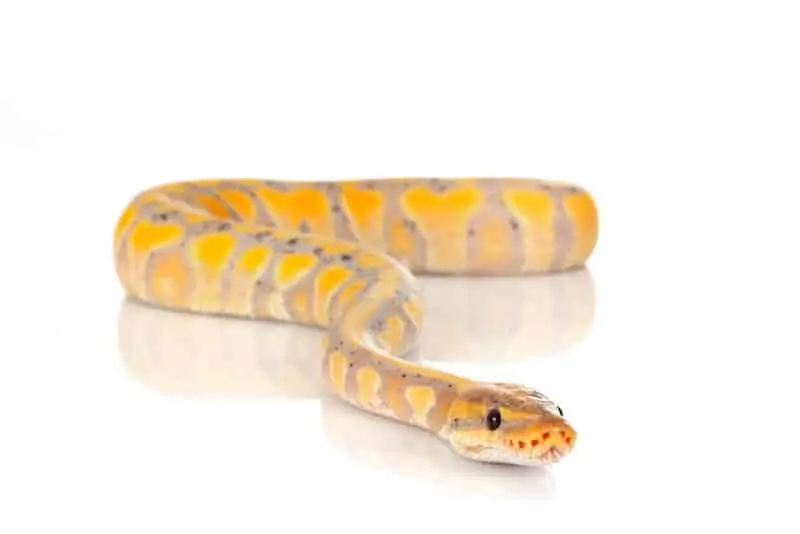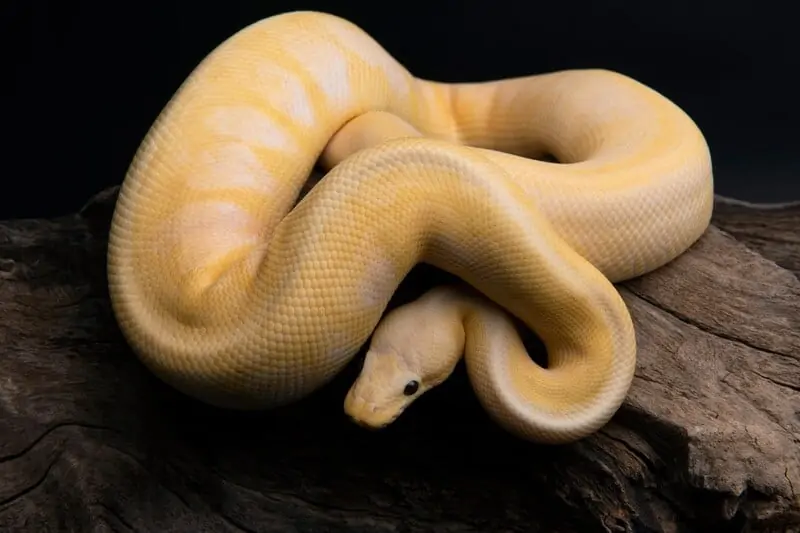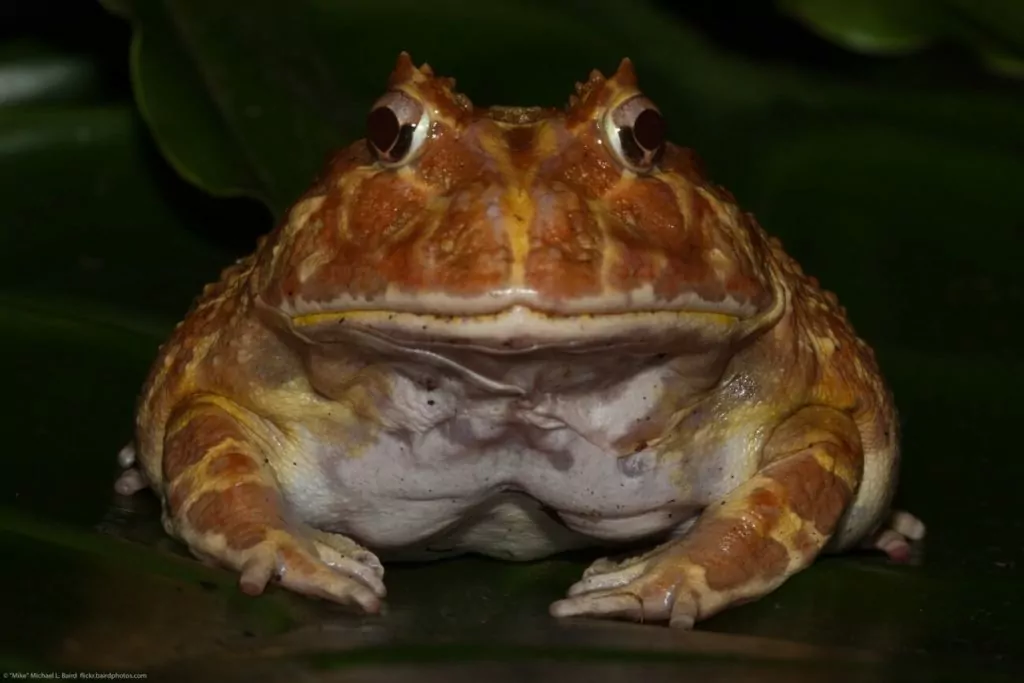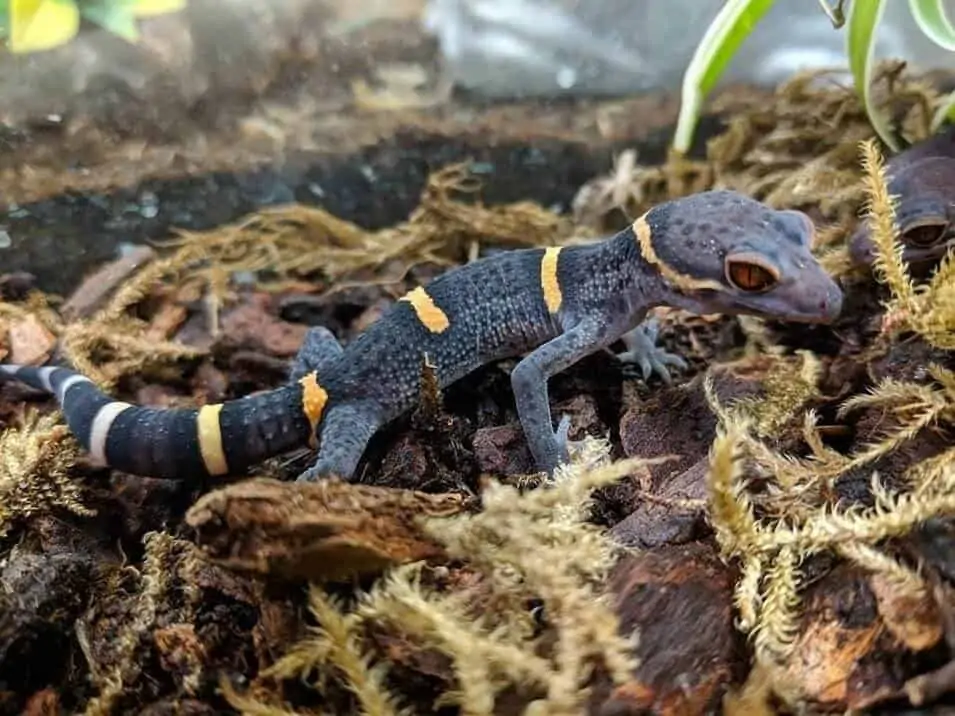Banana ball pythons are captivating snakes that can also make great pets. The combination of their beauty and low-maintenance care requirements makes them sought-after by many!
This guide will go over everything you need to know about banana ball python care, plus other helpful information to make ownership easier.
Table of Contents
Species Summary
Banana ball pythons (Python regius) are stunning creatures worthy of showing off as part of your snake collection. Thanks to their attractive colors, these snakes are among the more popular variants in the ball python family.
Bananas aren’t a unique species or subspecies. Instead, they’re a sought-after morph. The exact number is unknown, but herpetology experts estimate over 4,000 different ball python morphs in the world. These banana-colored beauties are just one of many options at your disposal.
Most morphs are a product of selective breeding, and bananas are no different. Most of the snakes you see on the market today were selectively bred. Interestingly enough, the unique coloration can occur naturally in West African snakes. But, it’s an extreme rarity.
Expert Tip: That’s why breeders love to create these pet snakes in captivity. The first banana ball pythons appeared on the market in 2003 with price tags as high as $25,000! Fortunately, these snakes are widely available nowadays. You can easily find one for less than $200, depending on the coloration.
Appearance & Colors
Take one look at the banana ball python, and you’ll know why snake-lovers adore these creatures!
Typically, banana ball pythons have a tan-colored base. On top of that, you’ll see patches of brightly colored yellow. The yellow sections are vibrant, making them stand out nicely against the relatively muted base.

Accompanying those patches of yellow are tiny freckles of dark brown. Put it all together, and you have a look that’s reminiscent of everyone’s favorite yellow fruit!
Slight variations can exist here and there. From the original banana ball pythons, breeders created other unique morphs. Some examples include:
- Banana pied ball pythons
- Banana clown ball pythons
- Banana spider ball pythons
- Black pastel banana ball pythons
- Banana cinnamon ball pythons
- Banana enchi ball pythons
- Banana mojave ball pythons
- Chocolate banana ball pythons
In these other morphs, you’ll still see the iconic yellow. However, the snake may have patches of lavender, darker orange, or other defining features. The trait that links them all is the incomplete dominant genetic mutation resulting in the yellow coloration.
Colors aside, banana ball pythons have all of the same features as your standard ball python. They’re stocky snakes that live sedentary lifestyles. The species is quite muscular, as it’s a natural-born constrictor that suffocates its prey before eating it.
Ball pythons are non-venomous, so they lack fangs. Instead, these snakes have as many as 100 inward-facing teeth.
The head is triangular shaped, but it’s not as pointed as other species. The snout is pretty broad and rounded. Occasionally, you’ll see their signature forked tongue pop out as they “taste” their surroundings.
Average Banana Ball Python Size
Banana ball pythons are pretty girthy snakes, but they aren’t super long. The average banana ball python size is between two and five feet when full grown.
The wide size spectrum is because of differences between males and females. Upon first glance, the sexually dimorphic nature of the snake isn’t ultra noticeable. But when you put the two sexes side by side, you’ll notice that there’s a significant size discrepancy.
Females can grow much larger than males. Full-grown females have an average length between three and five feet. Meanwhile, males are only about two or three feet in length.
Lifespan
The average banana ball python lifespan is between 20 and 30 years. You might hear of rare cases of these snakes living longer than three decades. While that’s certainly possible, the standard 20 to 30 years is a more reasonable expectation.
These snakes can provide you with many years of joy. However, you have to put in the work to keep them healthy. There’s no way to know for sure that your snake will live a long life.
The best thing you can do is provide the best husbandry possible. Do your part to meet the snake’s needs to a tee. That way, you can reduce stress and avoid potential health complications.
Banana Ball Python Care
Whether you’re a seasoned snake collector or a complete newbie, banana ball pythons make fantastic pets. Despite their somewhat intimidating looks and size, these creatures are docile and easy-going. They’re not super active and rarely show signs of aggression.
Like all reptile pets, the key to banana ball python care is being consistent about fulfilling their basic needs. Here are established care guidelines that cover housing, diet, and more.
Enclosure Size
While many assume that a massive enclosure is always the better choice, that’s not the case with banana ball pythons. These snakes can feel overwhelmed when they live in large, open environments. They prefer to live solitary lives in close quarters.
For this reason, it’s crucial to adapt the snake’s habitat as it grows bigger.
Fresh hatchlings can live in a simple 10-gallon terrarium. As the snake reaches the juvenile phase after six months, you can move to a 20-gallon enclosure.
Adults should live in an enclosure that holds 60 gallons. Aim for dimensions around 48 inches long, 24 inches wide, and 12 inches tall.
Expert Tip: As a good rule of thumb, the habitat should be just as long as the snake. Meanwhile, width and height can be a quarter of the snake’s measurements.
So, what kind of enclosure works best? For most snake owners, a glass or plexiglass habitat is best. Transparent materials are great for keeping watch of your snake. Plus, the solid walls make it easier to maintain temperature and humidity levels.
If you want to go even simpler, you can keep your python in an opaque plastic tub. Many collectors go this route to save space and money. But it’s not all about convenience. Opaque habitats like that are excellent for the snake’s lifestyle. They prefer privacy, and the non-transparent walls of a plastic tub provide just the right amount of it!
Ultimately, the choice is up to you. A traditional aquarium works just fine, but you’ll need to work a bit harder to create the serene and private environment these snakes prefer.
What To Put In Their Habitat
Start with a layer of an absorbent substrate. The material you use serves a couple of purposes. Not only does it make cleaning up messes more manageable, but it can also contribute to the humidity levels.
Absorbent substrates hold onto water, creating the musty environment these snakes love.
The best materials for banana ball pythons are cypress mulch or orchid bark. Avoid using anything infused with oils or chemicals. Soil-based substrates aren’t suitable either, as the tiny particles irritate the nostrils and mouth.
If you’re in a pinch, newspapers and precut reptile carpet pieces can serve you well. However, it’s always best to aim for natural alternatives that mimic the snake’s natural habitat in the wild.
Next, install some hide boxes. These boxes are a crucial part of banana ball python care, and should be large enough for the snake to slither into during the day. Wood boxes, cardboard boxes, or molded plastic boxes are all suitable choices. Just make sure that there are no hard, jagged edges that could cut your snake’s skin.
Place the hide box on opposing sides of the enclosure. That way, your snake can thermoregulate as it pleases. More on that in a bit!
Once you have the essentials, feel free to add more decorative items. These snakes appreciate loose moss, fake plants, and other forms of cover. They’re not required, but they can add some more privacy, as we mentioned earlier.
Expert Tip: Don’t overdo it! It’s better to give your snake plenty of room to move than to overstuff the habitat with unnecessary decorations.
Temperature & Lighting
Hailing from the hot climates of West Africa, banana ball pythons require warm environments. If temperatures drop out of the comfort zone, your pet snake could encounter a world of health problems.
It’s not just simple heat you need to provide. These cold-blooded animals require a temperature gradient to thermoregulate. One side has to be warmer than the other so that the snake can move about as it pleases.
To create your gradient, use a lighting system, heat emitters, or under-tank heating pads.
On the cool end, aim for ambient temperatures of around 75 to 80 degrees Fahrenheit. Don’t let the temperature readings dip below 75. Pay close attention at night and use non-lighted heating methods to keep things stable if necessary.
The other side of the enclosure should be a bit warmer. For the opposite end, set your lights to warm things up between 80 and 85 degrees Fahrenheit.
Finally, use a basking lamp to create one area of centralized heat. The basking spot should be 88 to 92 degrees Fahrenheit. Make sure to place the light in a safe location out of reach from your snake.
Once you have the standard lights in place, place everything on a timer. Banana ball pythons require simulated lighting conditions that recreate the typical day and night cycle. Without it, the snake’s entire circadian rhythm can go out of whack, affecting feeding, shedding, and more.
Humidity
Purchasing a hygrometer is mandatory when it comes to banana ball python care. A hygrometer measures the humidity levels, ensuring that things are just right around the clock.
Banana ball pythons need stable humidity levels between 50 and 60 percent. This is not something you should take lightly! Too little or too much moisture in the air can cause many health problems and pave the way for bacteria to take over.
Luckily, there are many ways to make adjustments. If you need to raise the humidity, spritz the enclosure with water. The absorbent substrate will hold onto the water and slowly release it for evaporation, creating a stable environment.
You can mist daily or install an automatic dripper.
If humidity levels are too high, all you have to do is increase airflow. You can do that by opening any vents and allowing more fresh air to pour in.
Water
A shallow water bowl is a must for any banana ball python enclosure. Many novice snake owners miss this accessory, and their pet suffers the consequences.
Ball pythons use water dishes in several ways. On rare occasions, you might see them drink the water. However, you’re more likely to witness them soaking.
Soaking helps to lower body temperature and speed up the shedding process.
Install a large dish that’s spacious enough for your snake to slither in. Use a heavy bowl when possible. These snakes can end up tipping it over and making a mess, so you want to get a spill-proof model if you can.
Fill the container with clean, dechlorinated water. Keep an eye on it and replenish the water if messes occur. Don’t be surprised if you see your snake defecate in it.
Make it a habit to consistently clean the mess up, wash the bowl, and provide more fresh water to keep your snake healthy.
Food & Diet
When it comes to feeding, banana ball pythons are pretty straightforward. They are exclusive carnivores that only eat rodents in captivity.
In the wild, the snake’s diet is a little more varied. They might eat mice, birds, and other reptiles that are unlucky enough to cross the snake’s path. However, you don’t have to deal with all that when caring for a captive snake.
Feeder rodents are readily available at most pet stores.
You can provide live feeder mice. Doing so might help add another layer of enrichment as the snake “hunts” for their food. That said, live mice can fight back! Scratches and bites could cause potential health problems.
For this reason, most herpetology buffs agree that thawed, frozen mice are the way to go.
Juveniles need to eat small pinkies and fuzzies every five to seven days.
Meanwhile, adults need a large rat every seven to ten days. They may need to feed more frequently during shedding periods, but seven to ten days is the norm.
Expert Tip: When choosing feeder rodents, make sure to select specimens that are smaller than the widest point of your snake’s body.
Bring the rodent to room temperature before feeding. Then, use a pair of tongs and a gloved hand to feed your snake. Make sure to avoid handling for at least a day after eating.
Potential Health Issues
For the most part, banana ball pythons are healthy creatures. They don’t have an increased risk for diseases.
That said, they can experience common ailments that come from poor care. The most common issues are mouth rot, respiratory infections, skin mites, and parasites.
Respiratory infections, mouth rot, and any other disease involving the sinuses usually result from poor environmental conditions. Symptoms include inflamed tissue and discharge.
Check your thermometer and hygrometer to ensure that conditions are within the accepted range.
Skin infections, snake mites, and parasites are a direct result of a dirty environment. Bacteria and mold can flourish even in well-maintained tanks. The key to avoiding those problems is to clean regularly.
Spot clean messes and perform a deep sanitization twice a month. During the deep clean, you want to disinfect every surface. You can use a five percent bleaching solution or any other reptile-approved sanitizer.
Expert Tip: Make sure to wash your hands thoroughly when handling your snake or any other reptile. Parasites and mites are highly contagious and usually come from infected items introduced into the environment. Wash your hands, and you can easily avoid those problems.
Behavior & Temperament
Banana ball pythons are some of the most docile reptiles you can own.
They rarely show signs of aggression. The only time you’ll see that is if the snake has a bad history of abuse or if you keep more than one snake in the same enclosure. Ball pythons are solitary animals, and you should keep each one alone.
During the day, your snake will lounge about and spend most of its time in the hide boxes. It may move around occasionally to thermoregulate, but ball pythons aren’t super active when the sun is up. When dusk arrives, the snakes become more active as they look for food.
Movement is slow but deliberate. They use their tongues to “taste” the environment and figure out their bearings.
Handling Them
Banana ball pythons do fine with moderate handling. But even then, you have to build up trust before handling becomes a regular thing.
It’s not uncommon to see shy behavior when you bring a new snake home. Let it get acclimated into its new environment before attempting to bond.
In the beginning, keep contact brief and gentle. Try rubbing its back to gain trust. Eventually, you can move on to short handling sessions.
Lift the body at the broadest point before supporting the snake’s entire weight. It should wrap itself around your arm to get comfortable. Don’t apply too much pressure to the body and avoid making sudden movements that could startle the snake.
Over time, the timidness will disappear as your snake accepts your touch.
Closing Thoughts
No matter how much experience you have, banana ball python care shouldn’t intimidate you. Helping these snakes thrive is a piece of cake as long as you stick to the recommended care requirements.
We highly recommend this morph to anyone who can find them. They’re one of our favorites!



